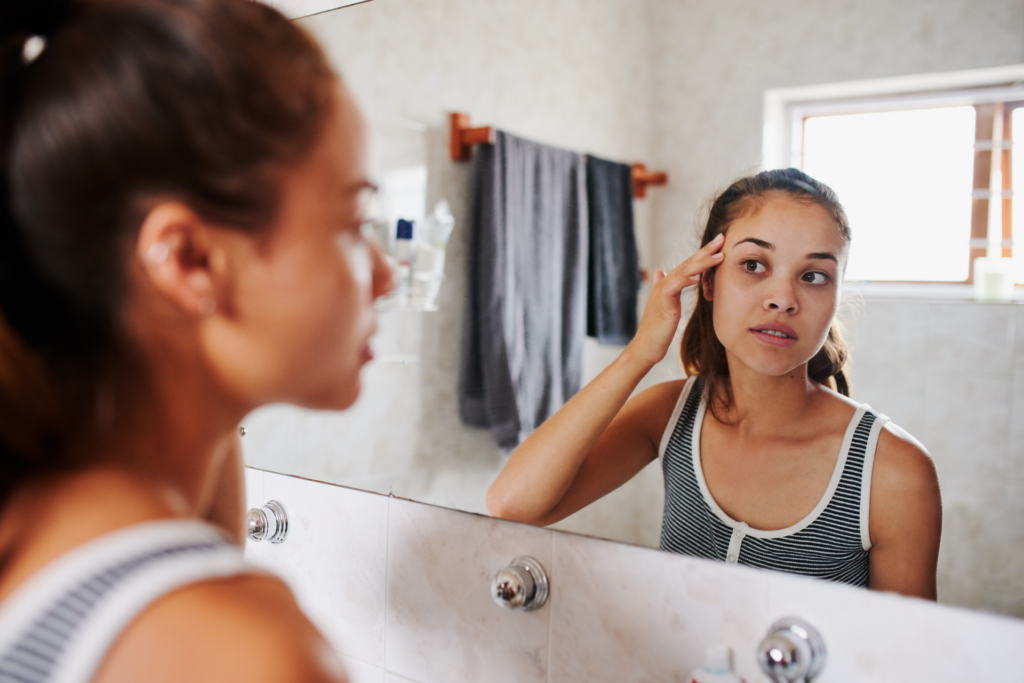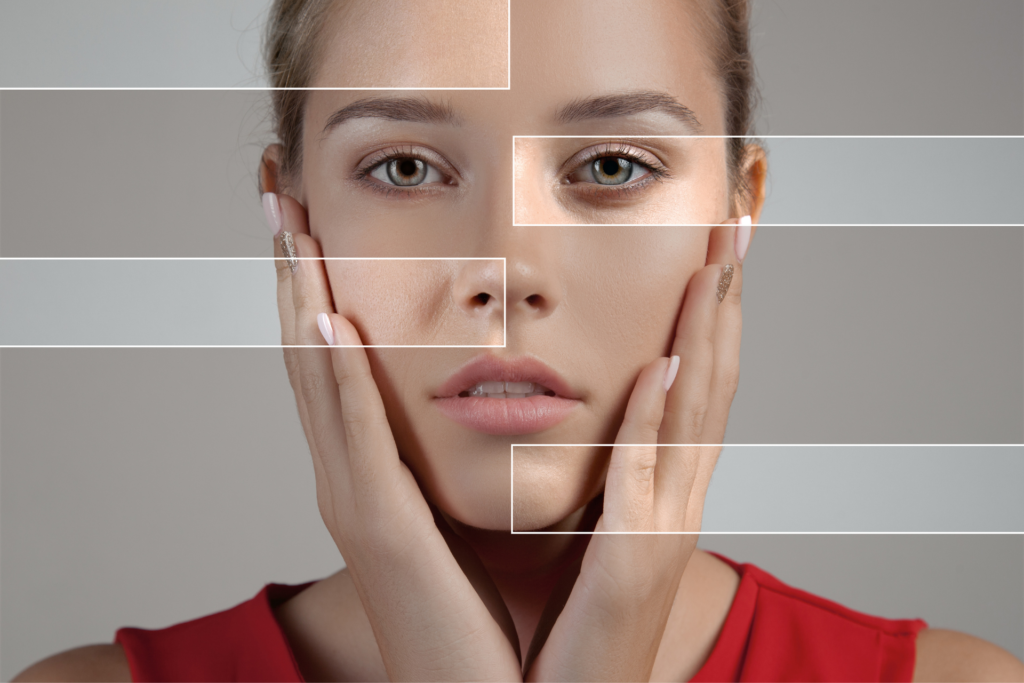You’ve probably heard a lot about pores if you’ve struggled with acne. Clogged pores, enlarged pores, and blocked pores contribute to the appearance of pimples. I’m guessing you’ve also purchased hundreds of products claiming to minimize or reduce the appearance of pores. But, how much do you really know about your pores?
Pores are a fundamental part of how our skin functions. Caring for your skin impacts the appearance of pores, contributing to healthy, glowing skin. That’s why I think it’s important to understand what pores are, how they become clogged, and the best way to take care of them.
There are also several misconceptions about pores. So, while we’re at it, let’s clear up some common myths about your pores. Plus, I’ll share a few of my favorite ways to help care for your pores.
What Are Pores?
Pores are the small openings in the skin that release oil and sweat to the surface of your skin. Pores are found all over the body except on the palms of your hands and the soles of your feet. On average, an adult has around 5 million pores on their body! 20,000 of those pores are on the face.
You have two different types of pores: sweat pores and oil pores.
Sweat Pores: Sweat pores are microscopic and cannot be seen by the naked eye. Sweat glands produce sweat released through the follicle and out onto the skin’s surface through the pore.
Oil Pores: Oil pores are large enough to be seen by the naked eye. Each pore on the skin is an opening called a follicle that contains a hair and an oil gland (also known as the sebaceous gland). The oil from the gland helps to remove old skin cells and protect the skin. Oil pores tend to get the most attention because they are most likely to become clogged.
Today, we’ll primarily be focusing on the oil pores.
Clogged Pores and Acne Development
Your pores have an essential job. The hair follicle helps the oil generated by the sebaceous glands (known as sebum) to reach the surface and lubricate the skin. Typically, your pores do a great job clearing out oil, dead skin cells, sweat, and other gunk. But sometimes, this process can go awry. Instead of being cleared up and out of the pore, oil and dead skin cells become trapped, clogging the pore and forming acne.
The acne caused by clogged pores can lead to the formation of blackheads or whiteheads. Or, if bacteria become trapped in the pores, more serious blemishes like inflamed papules, pustules, or cysts can form.
Many things can lead to clogged pores and the development of acne, including hormonal fluctuations, increased stress, genetics, improper cleansing of the skin, or using dirty makeup brushes or sponges.
What Is Sebum?
Sebum is a yellowish, oily substance produced by the sebaceous glands. This complex mixture of lipids flows to the surface of the skin, helping to lubricate and protect it. In addition, sebum also has antibacterial properties that make it the body’s first defense against infection.
Hormones regulate the production of sebum, particularly androgens such as testosterone. The sebaceous glands produce a significant amount of sebum immediately after birth when hormones are high and then slows during childhood and ramps up again at puberty. Generally, by age 20, sebum production starts to decrease again and continues to slow as you age.
Because hormones control sebum production, a hormonal imbalance can cause an over or underproduction of sebum which can lead to conditions including acne, oily skin, seborrheic dermatitis, or skin concerns such as dry, red, flaky, or itchy skin.
Debunking Common Misconceptions About Pores
There are so many misconceptions about skin, pores, and acne! Let’s debunk a few of my favorite myths so that you can help and care for your skin from the inside out.
Blackheads are a build-up of dirt in your pores.
Blackheads are not dirt. Sebum and dead skin cells build up in the hair follicle, causing blackheads. As the oil and skin cells fill the pore, they are exposed to oxygen in the air, turning them black.
You can change the size of your pores.
No matter what a skincare brand may claim, the size of your pores is primarily determined by genetics. You can, however, “reduce the appearance” of large pores by using skincare that keeps pores clearer – effectively reducing their appearance.
Sunscreen clogs pores.
Sunscreen is probably the most important product you’ll put on your skin. The key is to use the right sunscreen. Read more about choosing the right sunscreen.
Frequent face washing will prevent clogged pores.
Regular face washing can help improve the appearance of your blackheads by removing excess oil and dead skin cells; however, excessive face washing and vigorous washing with a washcloth or scrubs will cause irritation, dryness, and redness that may worsen breakouts. You simply can’t scrub your pores away; they are here to stay.
Your pores open and close.
Pores don’t open and close. Instead, pores dilate from wide to narrow, similar to a camera lens.
How to Care For Your Pores
Even though genetics and your skin type primarily drive how your pores look, proper skin care can still impact the appearance of your pores. When caring for your pores (and your skin), it’s essential to use products that help treat clogged pores and prevent them from occurring in the first place. The following are a few of my favorites when caring for your pores:
Retinoids. Retinoids are topical, prescription strength creams derived from vitamin A used to treat several skin conditions. A medication like Trethinion helps to stimulate cell turnover in the skin, exfoliating the top dead layers, and revealing smoother, healthier-looking skin.
Masks. Cosmetic face masks may not be a long-term remedy for acne, but they can help remove dead skin and other pore-clogging substances. In addition, masks can help calm inflamed skin and help prevent breakouts. Read more about a few of my favorite masks:
Peels. Chemical peels are a topical skin treatment that exfoliates a layer of the skin using a chemical solution, stripping away damaged or old skin cells to reveal the fresh layer underneath. Peels are excellent for treating skin issues like discoloration, acne scarring, pimples, and texture changes.
Read more about chemical peels for acne and aging.
Moisturizers. Moisturizers help keep skin feeling soft and refreshed. I recommend selecting a moisturizer with natural oils, such as argan, jojoba, or pumpkin seed oil, that can help regulate sebum and reduce inflammation associated with acne.
Learn more about my tips for your skincare routine, how to layer your products and the best natural oils for your skin.
Heal Your Skin Inside and Out
Learn how your skin integrates with your mind, body, and spirit to heal your skin inside and out. Discover how to stop your unpredictable breakouts so you can have clear skin with my SkinClock Method.
Limited spots are available.
Join my waitlist today and start your journey to healthy, glowing skin.
Resources
- “Sebaceous gland lipids – PMC – NCBI.” https://www.ncbi.nlm.nih.gov/pmc/articles/PMC2835893/. Accessed 14 Jun. 2022.
- “Sebocytes, multifaceted epithelial cells: lipid production … – PubMed.” https://pubmed.ncbi.nlm.nih.gov/19944183/. Accessed 14 Jun. 2022.


